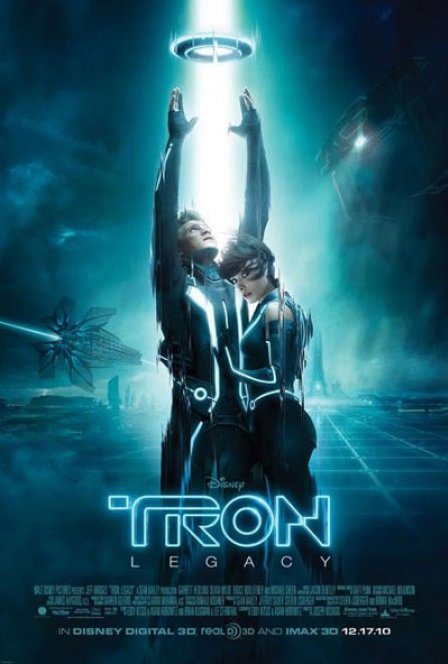The many multi-million dollar spectacles churned out every year usually suffer from a need for inclusion, the desire to please a majority of fans while adapting a popular series of comics, or needlessly adding a new chapter to a pre-existing franchise. TRON: Legacy is a sequel to a 1982 cult movie that, outside of those who recall it as a landmark in the history of computer-generated imagery, few today have seen. As of this writing, its DVD is out of print. Yet because of this, director Joseph Kosinski’s follow-up never feels like it’s trying hard to please, managing to avoid most of the pratfalls of its mainstream ilk and being brazen in all the right ways. The original TRON’s concept of the Grid — a virtual world found inside the software of video games, which resembled a blueprint colorfully come to life — deserves an expensive makeover, and TRON: Legacy’s state-of-the-art visuals speak for themselves, keeping a relatively uninteresting plot from bogging them down. “It’s biodigital jazz, man,” says Jeff Bridges at one point in the film, and I couldn’t think of a better way to describe its effect on the viewer, both in its abundance of technical vernacular and eye-popping splendor.
Neatly paced for two hours, TRON tells the story of Sam (Garrett Hedlund), techie son of Flynn (Bridges), a software programmer, who attempts to bring his father back from the aforementioned Grid that he created back in the 80s. When he enters his father’s retro arcade and hacks into the downstairs computer, he is thrust into the game arena. He is a “user” in the world of “programs,” a pre-Avatar concept where discs used to store one’s identity are thrust at each other to provide certain digitized death or deresolution. Saved by a black-haired siren in a tightly fitted suit (Olivia Wilde), he is brought to his exiled dad, now a Zen figure in a white robe, who speaks of failed dreams of perfection in his ever-expansive universe.
The trouble with TRON: Legacy’s plot is that it hardly offers a strong reason for us to care about the rules of its world. By the time we meet the renegade program Clu, a laughably CGI’d version of Bridges that resembles the smirking avatar of Aphex Twin, the faux-profound reasons behind the eventual escape from the Grid have taken less precedence in our minds than the film’s arresting imagery.
TRON: Legacy works best when it’s being flashy, and even then its visual compositions are like few I’ve seen in recent big-budget cinema. The movie feels like it’s taking cues from Chris Cunningham’s icy “All Is Full of Love” music video and the Wachowskis’ sorely underrated Speed Racer, in that its digital sheen is never sacrificed for choppy editing and a lack of visual clarity that many films employ for effect. Taking place in a “world without sun,” we finally have a 3D movie where the glasses’ added darkness suits the film’s own world, with occasionally wondrous scenes of multiple planes of vision in motion. The film’s pungent blue-and-hazy-white color scheme is captured in pleasantly wide cinematography, while almost every scene with expository dialogue is framed with a striking symmetry.
I understand the lukewarm response by fans to the mega-hyped soundtrack by veteran electronic music duo Daft Punk, as it’s true that the music rarely calls attention to itself: a standard horns-and-violins swell that resembles a toned down Inception. Yet various iterations of pulsating bass occasionally appear to give the computerized goings-on a strangely sexy vibe, much like the film itself. Sure, TRON: Legacy may not be the revolutionary cybernetic adventure some want it to be, but it’s one of the most visually competent in years, not to mention one of the grooviest.

